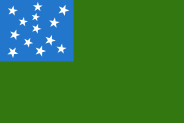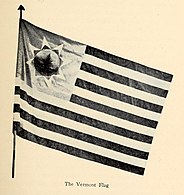Flag of Vermont
 | |
| Use | Civil and state flag |
|---|---|
| Proportion | 3:5 |
| Adopted | June 1, 1923 |
| Design | The Vermont state coat of arms defacing a field of azure. |
The flag of the State of Vermont consists of the coat of arms and motto of Vermont ("Freedom and Unity") on a rectangular blue background. The Vermont General Assembly adopted the current flag on June 1, 1923.
Multiple versions of the flag have been included throughout history. Originally, the flag was the same as the flag of the Green Mountain Boys. It was then changed to look similar to the flag of the United States, consisting of red and white stripes, and a blue canton. It was changed to be dissimilar to avoid confusion.[1] Proposals have been brought up to revert the flag back to the Green Mountain Boys' flag, but none have succeeded.[2]
Symbolism[]
The flag consists of the state's coat of arms and motto on a field of azure. While the pine needle supporters of the coat of arms are represented throughout New England and symbolizes the small pine branches worn at the battle of Plattsburgh near the end of the War of 1812,[3] the pine tree in the middle of the coat of arms represents the Vermont forests.[4] The cow and three sheaves of wheat represent the dairy and agriculture industries.[5] The deer head on top represents Vermont's wildlife.[4] The Green Mountains are in the background as well. The motto, "Freedom and Unity", is also used. The motto balances two different ideals, the freedom of the individual citizen, and the welfare of the common good.
History[]
| Historic Vermont Flags |
|---|
 Green Mountain Boys flag, the militia flag of the Vermont Republic |
 The second flag of Vermont used from May 1, 1804, to October 19, 1837. |
 The third flag of Vermont used from October 20, 1837, to May 31, 1923. |
 Black and white photograph of Vermont's third flag.[6] |
There is no record today of a design for an official Vermont Flag prior to 1804, although Ira Allen's design—common to both the Great Seal of Vermont and the coat of arms of Vermont—dates to 1778.[7] While an official government flag might not have existed prior to 1804, the Vermont militia—known as the Green Mountain Boys—was formed in 1770, and remaining accounts record use of the Flag of the Green Mountain Boys as far back as 1777.[8][9]
On May 1, 1804, the number of U.S. states rose to seventeen, and it was expected that the U.S. flag would change to 17 stars and 17 stripes. In recognition, Vermont adopted what was expected to be the new U.S. flag with the addition of the name "VERMONT" embroidered along the top. The U.S. flag did not change in that way, resulting in the Vermont flag having more stripes than the national flag.[1]
On October 20, 1837, Vermont changed its flag to a design based on the current 13-stripe U.S. flag, but with the multiple stars of the blue canton replaced with a single large star surrounding Vermont's coat of arms. The flags based on these specifications varied in the number of points on the star (five and eight, with eight slightly more common), and the exact details of the center of the star (with either the Great Seal or the coat of arms being used).[1]
During the American Civil War, the Spanish–American War and World War I, the Vermont militia fought under a banner composed of the Coat of arms of Vermont on a blue field.[7] This was essentially the same as the Vermont Governor's flag, and very similar to the current state flag.
Because of confusion between the striped Vermont state flag and the U.S. flag, the design of the Vermont Governor's flag was adopted as the official state flag on June 1, 1923.[1][10]
See also[]
- State of Vermont
- Symbols of the state of Vermont
- Great Seal of the State of Vermont
- Symbols of the state of Vermont
- Flags of the United States
References[]
- ^ a b c d "The Vermont State Flag". NetState.com. September 24, 2009.
- ^ "Archived copy". Archived from the original on 2012-07-15. Retrieved 2012-04-30.
{{cite web}}: CS1 maint: archived copy as title (link)> - ^ Znamierowski, Alfred. The World Encyclopedia of Flags. Italy: Lorenz Books, 1999. 199. Print
- ^ a b "Vermont State Symbols". ThinkQuest.org. September 23, 2010.
- ^ "Vermont State Flag". American Flag & Gift. July 15, 2009. Archived from the original on May 16, 2008. Retrieved May 20, 2008.
- ^ "Vermont, the Green Mountain state ; v. 5". Internet Archive. 2010-07-21. Retrieved 2019-03-11.
- ^ a b Benedict, G. G. (March 1902). Charles S. Forbes, Charles R. Cummings (ed.). "The Vermont Flag". The Vermonter. Charles S. Forbes publisher. VII (8).
- ^ Hossell, Karen Price (2004). Ethan Allen. Heinemann-Raintree Classroom. ISBN 9781403450845.
- ^ Bennett, William J.; John T. E. Cribb (2010) [2008]. "Flags of the Revolutionary War". The American Patriot's Almanac. Thomas Nelson Inc. ISBN 9781418570989.
- ^ "Vermont Laws".
External links[]
- "Emblems & Vermont State Flag". Vermont Secretary of State. Archived from the original on 2006-09-23.
- United States state flags
- Symbols of Vermont
- Flags introduced in 1923
- Flags displaying animals
- Flags of Vermont
